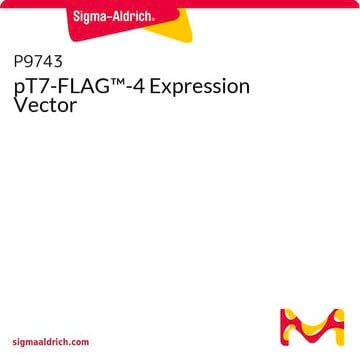E7658
p3XFLAG-CMV™-10 Expression Vector
shuttle vector for transient or stable expression of N-terminal 3xFLAG
Anmeldenzur Ansicht organisationsspezifischer und vertraglich vereinbarter Preise
Alle Fotos(2)
About This Item
UNSPSC-Code:
12352200
eCl@ss:
32190102
Empfohlene Produkte
Markierung
3X FLAG tagged
Qualität
for molecular biology
Form
buffered aqueous solution
Lage der Peptid-Tags
N-terminal
Versandbedingung
dry ice
Lagertemp.
−20°C
Allgemeine Beschreibung
The p3XFLAG-CMV™-10 Expression Vector is a 6.3 kb derivative of pCMV5 used to establish transient or stable intracellular expression of N-terminal 3XFLAG™ fusion proteins in mammalian cells. The vector encodes three adjacent FLAG® epitopes (Asp-Tyr-Lys-Xaa-Xaa-Asp) upstream of the multiple cloning region. This results in increased detection sensitivity using ANTI-FLAG M2 antibody. The third FLAG epitope includes the enterokinase recognition sequence, allowing cleavage of the 3XFLAG peptide from the purified fusion protein. Efficiency of replication is optimal when using an SV40 T antigen expressing host.
The p3XFLAG-CMV-7-BAP Control Plasmid is a 6.2 kb derivative of pCMV5 used for transient intracellular expression of N-terminal 3X-FLAG bacterial alkaline phosphatase fusion protein in mammalian cells. The vector encodes three adjacent FLAG epitopes (Asp-Tyr-Lys-Xaa-Xaa-Asp) upstream of the multiple cloningregion. This results in increased detection sensitivity using ANTI-FLAG M2 antibody. The third FLAG epitope includes the enterokinase recognition sequence, allowing cleavage of the 3XFLAG peptide from the purified fusion protein.
Vector Maps and Sequences
The p3XFLAG-CMV-7-BAP Control Plasmid is a 6.2 kb derivative of pCMV5 used for transient intracellular expression of N-terminal 3X-FLAG bacterial alkaline phosphatase fusion protein in mammalian cells. The vector encodes three adjacent FLAG epitopes (Asp-Tyr-Lys-Xaa-Xaa-Asp) upstream of the multiple cloningregion. This results in increased detection sensitivity using ANTI-FLAG M2 antibody. The third FLAG epitope includes the enterokinase recognition sequence, allowing cleavage of the 3XFLAG peptide from the purified fusion protein.
Vector Maps and Sequences
Komponenten
p3XFLAG-CMV™-10 Expression Vector 20 μg (E4401) is supplied as 0.5 mg/ml in 10 mM Tris-HCl (pH 8.0) with 1 mM EDTA.
p3XFLAG-CMV™-7-BAP Control Plasmid 20 μg (C7472) is supplied as 0.5 mg/ml in 10 mM Tris-HCl (pH 8.0) with 1 mM EDTA.
p3XFLAG-CMV™-7-BAP Control Plasmid 20 μg (C7472) is supplied as 0.5 mg/ml in 10 mM Tris-HCl (pH 8.0) with 1 mM EDTA.
Prinzip
The promoter-regulatory region of the human cytomegalovirus3 drives transcription of FLAG®-fusion constructs. The aminoglycoside phosphotransferase II gene (Neo-r) confers resistance to aminoglycosides such as G418 allowing for selection of stable transfectants.
Rechtliche Hinweise
This product is covered by the following patents owned by Sigma-Aldrich Co. LLC: US6,379,903, US7,094,548, JP4405125,EP1220933, CA2386471 and AU774216.
3xFLAG is a trademark of Sigma-Aldrich Co. LLC
FLAG is a registered trademark of Merck KGaA, Darmstadt, Germany
p3xFLAG-CMV is a trademark of Sigma-Aldrich Co. LLC
Lagerklassenschlüssel
10 - Combustible liquids
Analysenzertifikate (COA)
Suchen Sie nach Analysenzertifikate (COA), indem Sie die Lot-/Chargennummer des Produkts eingeben. Lot- und Chargennummern sind auf dem Produktetikett hinter den Wörtern ‘Lot’ oder ‘Batch’ (Lot oder Charge) zu finden.
Besitzen Sie dieses Produkt bereits?
In der Dokumentenbibliothek finden Sie die Dokumentation zu den Produkten, die Sie kürzlich erworben haben.
Kamlesh K Bisht et al.
Journal of cell science, 126(Pt 15), 3493-3503 (2013-06-05)
Sister chromatid cohesion relies on cohesin, a complex comprising a tri-partite ring and a peripheral subunit Scc3, which is found as two related isoforms SA1 and SA2 in vertebrates. There is a division of labor between the vertebrate cohesin complexes;
Hong Soon Kang et al.
Molecular and cellular biology, 29(24), 6366-6379 (2009-10-07)
In this study, we report that the Krüppel-like zinc finger transcription factor Gli-similar 3 (Glis3) is induced during the secondary transition of pancreatic development, a stage of cell lineage specification and extensive patterning, and that Glis3(zf/zf) mutant mice develop neonatal
Qi Ming Li et al.
The Journal of neuroscience : the official journal of the Society for Neuroscience, 27(31), 8395-8404 (2007-08-03)
Although oligodendrocytes undergo apoptosis after spinal cord injury, molecular mechanisms responsible for their death have been unknown. We report that oligodendrocyte apoptosis is regulated oppositely by c-Jun N-terminal kinase 3 (JNK3) and protein interacting with the mitotic kinase, never in
Heehyoung Lee et al.
Molecular and cellular biology, 26(14), 5259-5269 (2006-07-01)
Histone deacetylases (HDACs) are enzymes that regulate the functions of histones as well as nonhistones by catalyzing the removal of acetyl groups from lysine residues. HDACs regulate many biological processes, including the cell division cycle and tumorigenesis. Although recent studies
Yan Ren et al.
Molecular & cellular proteomics : MCP, 12(2), 485-498 (2012-12-04)
Tumor hypoxia induces cancer cell angiogenesis, invasiveness, treatment resistance, and contributes to poor clinical outcome. However, the molecular mechanism by which tumor hypoxia exerts a coordinated effect on different molecular pathways to enhance tumor growth and survival and lead to
Unser Team von Wissenschaftlern verfügt über Erfahrung in allen Forschungsbereichen einschließlich Life Science, Materialwissenschaften, chemischer Synthese, Chromatographie, Analytik und vielen mehr..
Setzen Sie sich mit dem technischen Dienst in Verbindung.








